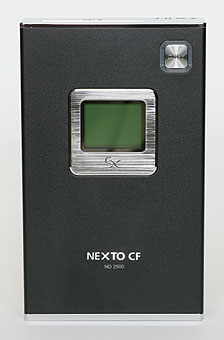

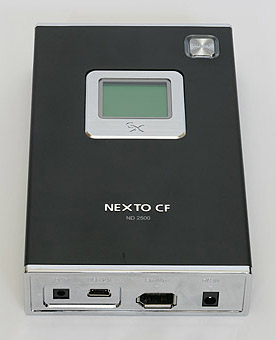
Display and Button
BAT | USB 2.0 | FireWire | DC IN
The NEXTO CF ND-2500
is out of production.
The successor is the
NEXTO CF Ultra ND-2525.
Attention! The review below is based on the initial feature set of NEXTO CF. The new Firmware 1.3 adds some key features:
What is NEXTO CF?
Optional Accessories: 5 in 1 CF Adapter External Battery Pack
Notes on Use: Connectors Charging Display Normal Use PC Connection Firmware Formatting
Test Results Overview
Detailed Test Results: PC Interface Card Reader CF / CF Adapter Card Copy CF / CF Adapter Harddisks Battery Internal / External Special Tests
 |
 |
 |
| NEXTO CF - Front View Display and Button |
NEXTO CF - CF Slot | NEXTO CF - Connectors BAT | USB 2.0 | FireWire | DC IN |
At first glance, the NEXTO CF ND 2500 by NextoDI, Inc. seems to be just another PSD with CF copy feature. However, there are some details that might not be obvious.
The NEXTO CF is produced in Korea. Unfortunately, there are no worldwide distribution channels. There is an importer in Germany, who will also deliver to most EU countries. The price for the NEXTO CF without harddisk from the importer is currently 129 Euro. Another option is to order the NEXTO CF directly from Korea, where you have to add the costs for worldwide express delivery and - depending on the destination country - import taxes and/or VAT.
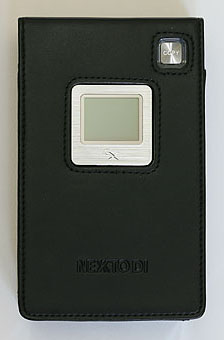 |
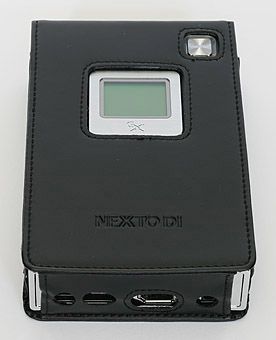 |
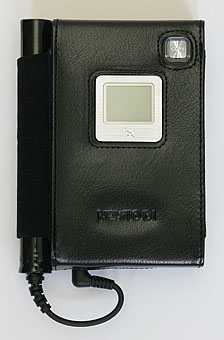 |
| NEXTO CF Standard Leather Pouch |
Standard Leather Pouch Connector View |
NEXTO CF Pouch for Optional Battery Pack |
NEXTO CF only has a built-in CF slot. For other media, you need a CF adapter.
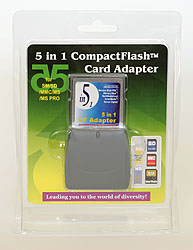
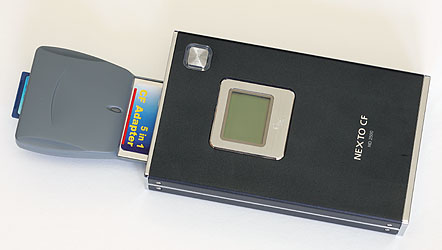
The optional 5 in 1 CF adapter supports SD, MMC, Memory Stick, Memory Stick PRO and SmartMedia.
The adapter can be used in any CF Type I slot. It has a total length of 89.5mm, maximum width of 52.4mm, maximum thickness of 13.2mm and a weight of 30g. All cards can be inserted in their natural orientation, which means that SmartMedia has to be inserted with the contacts facing up, the other cards with the contacts facing down.
When used with the NEXTO CF, the adapter sticks out 65mm, which is quite a lot comapred to the size of the NEXTO CF. Cards can be changed without the need to remove the whole adapter from the NEXTO CF.
The following media types are supported:
The internal battery has a capacity of about 600mAh and will power the NEXTO CF for about 45-70 minutes, depending on the power requirements of the harddisk and the media used (especially Microdrive versus CF card).
For higher autonomy, an external 1800mAh battery pack is available.

The battery pack consists of two Li-Ion cells (most likely 1865 type) with a short cable and plug. The battery pack has a diameter of about 19mm and a length of 137mm (not inluding the cable outlet and cable). The cable can be bent so that the total length is about 150-155mm. The battery pack has a weight of 88g, which seems a little much compared to a set of 4 AA cells. But the battery pack holds 13.32Wh, while a set of 4 AAs of 2600mAh theoretically (as it is only the printed capacity) holds 12.48Wh. The real-life capacity of NiMH cells might be 20% below that value, not to speak of the self-discharge rate.
The battery pack is supposed to be attached to the side of the NEXTO CF. There is a special pouch available with some kind of stocking to hold the battery. The outer dimensions for the NEXTO CF with the pouch including the battery pack and cables are 100x155x31mm³. The maximum total weight of NEXTO CF, harddisk, pouch and battery pack will be about 380g.
As mentioned above, the manual is not very chatty. There's nothing important you wouldn't find out during use, but it would be nice to know all the details. Here are a few things worth mentioning.
The first thing I was wondering about were the two connectors "DC IN" and "BAT". Actually, you can't do anything wrong, because the AC plug does not fit the BAT connector. The car charging adapter also plugs into the DC IN, which turns out to be designed for voltages around 12V. The BAT is for the optional battery pack with two-cell Lithium Ion design, i.e. 7.4V. The manual states that this connector is only intended for use with the optional battery pack, and that using other batteries could be dangerous. The battery plug won't fit the DC IN connector, so you can't do anything wrong either. This is an excellent safety feature.
Although you should not mess with the DC IN and the BAT connectors, here are the dimensions of the plugs needed: The DC IN connector requires 3.4-3.5mm outer diameter and 1.3-1.4mm inner diameter. The BAT connector requires 2.4-2.5mm outer diameter and about 0.7-0.8mm inner diameter.
The NEXTO CF will only charge while it is powered off. You can either charge the NEXTO CF through the DC IN connector with the supplied AC adapter or car charging adapter, or through a host-powered 6-pin FireWire connection. While charging, the display will stay off, but the border around the button will light up in red. When charging is complete, the red light goes off. Charging the internal battery will take 70-90 minutes, charging the external battery will take about 3 hours.
The display is a dot matrix LCD, so it could display anything. However, the actual display is arranged in four lines of 12 characters each.
To turn the NEXTO CF on, you simply press the button. As a safety feature, NEXTO CF cannot be powered on immediately after it was turned off. You will experience this if you are too slow with inserting or removing the card, NEXTO CF powers off, and you want to turn it back on. In that case, you simply have to wait a few seconds before turning it on again. After powering on, NEXTO CF will display the firmware version for a moment, e.g. "NEXTO-CF V1.15". If everything is ok, it will display "X-copy ready".
If you insert a memory card, NEXTO CF will parse the directories and shortly display "Parsing CF..". If the files have not yet been copied to the harddisk, the number of files will be displayed and a short press will start the copy process. If the files have already been copied to the harddisk (same filenames and timestamps), NEXTO CF will display "Same Image! Copy Again?" and a short press will start the copy process. If you don't want to take any action, you simply remove the memory card.
Each download will go to a separate directory. For details, see the next section.
For saving precious battery power, NEXTO CF will power off after 30 seconds. This mostly happens after copying a card. Just power on again, and NEXTO CF will display the status from the previous action, usually "Prev copy success!".
The NEXTO CF offers USB 2.0 and FireWire connection. While connected to a PC, NEXTO CF cannot copy cards to the harddisk.
A USB connection can be established with the NEXTO CF powered off or powered on. The harddisk will show up as drive letter, the CF slot cannot be accessed. The NEXTO CF can be partially powered through the USB connection, depending on the available host power. USB host power will be indicated by a boxed "u" next to the battery indicator. Please note that the internal battery will be used, too.
The FireWire connection can only be established, when the NEXTO CF is powered on, because a FireWire connection during power-off will be used for charging the battery.
If the NEXTO CF is connected to a powered 6-pin FireWire socket, it will be fully powered, and the internal battery will not be used. This is indicated by a boxed "e" next to the battery indicator. If you connect the NEXTO CF to an unpowered FireWire socket, you can attach a USB cable after establishing the FireWire connection. Like this, NEXTO CF will use USB host power supporting the internal battery. Please note that the NEXTO CF cannot be fully powered using USB host power.
Through FireWire, the CF slot will show up as first drive letter, the harddisk will show up as second drive letter. Unlike with other multi-function devices, the two drives must be stopped one at a time. I would recommend stopping the harddisk first, since this is the more critical step. Just in case the system would freeze while disconnecting the card reader, the harddisk would already be stopped properly like this.
You will find a directory "NEXTODI" on the harddisk. Within this directory, NEXTO CF creates one directory for each download. These directories will have an 8-digit basename created from the file date of the most recent file on the card, and a 3-digit extension starting from 000 and counting up if a directory with the same basename already exits. This means that the first download will go to a directory like "20050530.000".
NEXTO CF acts like a normal external harddisk. If have the impression that the file transfer is too slow, don't blame it on the NEXTO CF. The usual reasons for slow file transfers are bad USB 2.0 hosts, crippled FireWire implementations (XP SP2) or simply slow harddisks.
The NEXTO CF was originally delivered with firmware versions 1.14, 1.15 and 1.16. The latest versions are 1.19 and 1.24. Attention: Both versions are the most recent versions as of today (July 2005). Version 1.19 will copy the files to the harddisk while leaving the data on the media untouched, while version 1.24 will delete all files from the media if the copy process was successful.
The firmware cannot be downloaded, it will be sent by automated mail. Please watch your mail carefully after requesting the firmware and check your spam filter if you don't receive the mail. As an alternative, you can put "nextodi.com" on the whitelist before requesting the firmware.
Because the firmware will be stored in the FireWire controller, the update can only be done through a FireWire connection. The firmware update utility was originally intended to be used by firmware developers, so it is not specifically user-friendly. Read the instructions carefully, and follow the steps exactly. Note: There were reports about faulty devices, but these faults were caused by improper firmware update. In that case you have to follow the recovery procedure described in the firmware update documentation.
If you install a new harddisk without any partitions, NEXTO CF will prompt whether to format the drive. If the formatting takes more than a few minutes, this is most likely due to a faulty firmware update (see above for more explanations).
On a blank harddisk, NEXTO CF will create a partition of up to 128GB. When the harddisk is already partitioned, NEXTO CF will choose the first FAT32 partition. If there is no FAT32 partition available, NEXTO CF will prompt to format the first partition.
To invoke this auto-formatting, you can either delete all partitions from the harddisk, or re-format the existing FAT32 partition with a filesystem other than FAT32. When disconnecting the NEXTO CF, it will prompt to format the partition.
Even if there is a problem with detecting and/or formatting the harddisk, you can connect NEXTO CF to a PC. Then you can try to fix the harddisk using appropriate tools.
Here's a short summary of the important test results:
These are the results of the tests I did so far. Now only some download tests with the optional 5 in 1 CF adapter are missing.
My NEXTO CF came bundled with an 80GB Hitachi Travelstar 5K100-80 HTS541080M9AT00 which is one of the fastest 2.5" harddisks as of today. The 100GB model of that series is a little faster, and the current 7K60 is supposed to be at most 12% faster. All these harddisks are not fast enough to max out the FireWire interface of the NEXTO CF. For USB 2.0, I get about 31MB/s. But the USB 2.0 performance depends a lot on the hardware, so your results may differ.
2006-05-23: This is the updated diagram using the Hitachi Travelstar 7K100-100 HTS721010G9AT00.

There is a simple explanation for the excellent performance: The NEXTO CF uses dedicated controllers for each interface. The USB 2.0 bridge is an smsc USB97C202. The FireWire bridge is the well known OXFORD SEMI OXFW911 together with a Texas Instruments TSB41AB1 1394a transceiver.
As stated above, the CF slot only shows up through the FireWire connection. The CF slot is detected as first device, the harddisk as second device.
I used my own cardcheck tool for the benchmarks. It fills the card with files of up to 1GB each and reads back the data.
NEXTO CF FireWire Card Reader Performance
| Card | Read | Write | Comment | |||||
| SanDisk Ultra II CF 2GB | 12.53MB/s | 8.59MB/s | Excellent results. | |||||
| Transcend 45x CF 4GB | 8.67MB/s | 5.71MB/s | Excellent results. | |||||
| RiData 52x CF 2GB | 4.59MB/s | 3.79MB/s | The card can go a lot faster. | |||||
| Transcend 30x CF 1GB | 4.28MB/s | 3.62MB/s | The card can go faster. | |||||
| Transcend 25x CF 1GB (1) | 4.32MB/s | 2.83MB/s | The card can be read a little faster. | |||||
| Transcend 25x CF 1GB (2) | 4.32MB/s | 2.93MB/s | The card can be read a little faster. | |||||
| RiData 25x CF 1GB (1) | 4.33MB/s | 2.77MB/s | The card can be read a little faster. | |||||
| RiData 25x CF 1GB (2) | 4.33MB/s | 2.90MB/s | The card can be read a little faster. | |||||
| Lexar 8x CF 16MB (2175A) | 5.10MB/s | 1.24MB/s | This is as fast as the card can go. | |||||
| Lexar 8x CF 16MB (2177A) | 2.75MB/s | 1.29MB/s | The read result is strange. | |||||
| SanDisk CF 16MB (2002) | 2.05MB/s | 0.85MB/s | This is as fast as the card can go. | |||||
As you can see, the performance depends a lot on the card. The result for the SanDisk Ultra II CF is excellent, the result for the Transcend 45x is good, the Transcend 30x works OK, but the result for the RiData 52x is bad. For the RiData 52x CF and the Transcend 30x CF, there are USB 2.0 card readers that show better performance. The really strange part are the results for the two Lexar 8x cards. The two cards show about 10% difference when used in card readers. But with the NEXTO CF, the difference is huge.
In the meantime, I received the optional 5 in 1 CF adapter. This adapter shows much better performance than the adapters I used before.
NEXTO CF FireWire Card Reader Performance with various CF Adapters
| Card | Adapter | Read | Write | Comment | ||||||||
| Panasonic SD 512MB (RP-SDH) | 5 in 1 CF Adapter | 8.42MB/s | 4.01MB/s | Read rate is very good. | ||||||||
| Transcend SD 45x 1GB | 5 in 1 CF Adapter | 7.53MB/s | 3.43MB/s | Read rate is excellent. | ||||||||
| RiData SD 1GB (sold as 45x) | 5 in 1 CF Adapter | 5.32MB/s | 3.11MB/s | Read rate is excellent, card can't write faster. | ||||||||
| Hama miniSD 128MB | miniSD to SD + 5 in 1 CF Adapter | 7.86MB/s | 3.36MB/s | Read rate is excellent. | ||||||||
| SanDisk TransFlash 128MB | TransFlash to SD + 5 in 1 CF Adapter | 8.38MB/s | 2.00MB/s | Read rate is excellent, card can't write faster. | ||||||||
| MMC 256MB | 5 in 1 CF Adapter | 2.51MB/s | 1.73MB/s | Read rate is outstanding. | ||||||||
| Hama RS-MMC 128MB | Snap-On MMC + 5 in 1 CF Adapter | 2.50MB/s | 1.72MB/s | Read rate is outstanding. | ||||||||
| SmartMedia 128MB | 5 in 1 CF Adapter | 6.10MB/s | 1.54MB/s | Read rate is very good. | ||||||||
| PixoMedia SmartMedia 32MB | 5 in 1 CF Adapter | 6.05MB/s | 1.35MB/s | Read rate is very good, write is excellent. | ||||||||
| Olympus SmartMedia 32MB | 5 in 1 CF Adapter | 6.01MB/s | 1.00MB/s | Read rate is very good, write is excellent. | ||||||||
| FujiFilm xD 16MB | xD to SmartMedia + 5 in 1 CF Adapter | 6.14MB/s | 1.04MB/s | Excellent. | ||||||||
| FujiFilm xD 64MB | xD to SmartMedia + 5 in 1 CF Adapter | 6.10MB/s | 1.39MB/s | Excellent. | ||||||||
| Olympus Type M xD 1GB | xD to SmartMedia + 5 in 1 CF Adapter | --- | --- | 1GB not supported, lower 512MB verified OK. | ||||||||
| SONY MS PRO Duo HS 1GB | MS Duo to MS + 5 in 1 CF Adapter | 5.41MB/s | 1.61MB/s | OK. | ||||||||
| Lexar Memory Stick 64MB | 5 in 1 CF Adapter | 1.51MB/s | 1.51MB/s | Excellent. | ||||||||
| SONY MS Duo 32MB | MS Duo to MS + 5 in 1 CF Adapter | 1.41MB/s | 1.29MB/s | Excellent. | ||||||||
| Transcend SD 45x 1GB | Minolta SD-CF 1 | 3.57MB/s | 3.28MB/s | |||||||||
| Panasonic SD 512MB (RP-SDH) | Minolta SD-CF 1 | 3.56MB/s | 3.25MB/s | |||||||||
| Hama miniSD 128MB | Minolta SD-CF 1 | 3.56MB/s | 3.25MB/s | |||||||||
| Transcend SD 45x 1GB | 4 in 1 PCMCIA + PCMCIA to CF | 4.35MB/s | 1.86MB/s | |||||||||
| Panasonic SD 512MB (RP-SDH) | 4 in 1 PCMCIA + PCMCIA to CF | 4.34MB/s | 1.94MB/s | |||||||||
| Hama miniSD 128MB | 4 in 1 PCMCIA + PCMCIA to CF | 4.35MB/s | 1.85MB/s | |||||||||
| SONY MS PRO Duo HS 1GB | SONY MSAC-M2 | 3.72MB/s | 1.41MB/s | |||||||||
| Olympus Type M xD-Picture Card 1GB | FujiFilm DPC-CF | 2.92MB/s | 1.62MB/s | |||||||||
| FujiFilm xD-Picture Card 64MB | FujiFilm DPC-CF | 4.42MB/s | 1.27MB/s | |||||||||
| FujiFilm xD-Picture Card 16MB | FujiFilm DPC-CF | 4.43MB/s | 0.97MB/s | |||||||||
| SmartMedia 128MB | 4 in 1 PCMCIA + PCMCIA to CF | 3.74MB/s | 1.52MB/s | |||||||||
The Minolta SD-CF 1 can go a lot faster. With card readers, I get up to 5.59MB/s read and 5.38MB/s write. The results for the 4 in 1 PCMCIA adapter are OK, the best values for that are 4.52MB/s read and 2.52MB/s write. The best card reader results for the SONY MSAC-M2 are 4.11MB/s read and 1.52MB/s write. The top scores for the FujiFilm DPC-CF are 5.91MB/s read and 1.62MB/s write.
The important fact is, that even with the slow adapters, all read rates with suitable media are above 3.5MB/s. This should still be faster than most current PSDs.
For the copy performance test, I prepared some cards with files of 3MB each. I did not fill the cards completely, but chose a number of files that would fit on all cards due to differences in available space. The file size of 3MB is assumed to be a usual file size for digital images.
NEXTO CF Copy Performance with CF Cards
| Card | Files | Time | Transfer | |||||
| SanDisk Ultra II CF 2GB | 640 x 3MB | 3min 08.40sec | 10.19MB/s | |||||
| Transcend 45x CF 4GB | 1280 x 3MB | 8min 52.25sec | 7.21MB/s | |||||
| RiData 52x CF 2GB | 640 x 3MB | 7min 42.37sec | 4.15MB/s | |||||
| Transcend 30x CF 1GB | 320 x 3MB | 3min 59.95sec | 4.00MB/s | |||||
The CF copy performance is below the CF card reader performance, because the copy process for individual files involves at least one directory and FAT update for each file written to the harddisk. Please note that the copy process will slow down while the harddisk gets filled: The sustained data rate decreases, and the seek time for the FAT updates increases constantly.
I just received the orignal 5 in 1 CF adapter and will do some copy tests later.
NEXTO CF Copy Performance with CF Adapters
| Card | Adapter | Files | Time | Transfer | ||||||
| SONY MS PRO Duo HS 1GB | SONY MSAC-M2 CF-I | 320 x 3MB | 4min 34.03sec | 3.50MB/s | ||||||
| Transcend SD 45x 1GB | Minolta SDCF1 | 320 x 3MB | 4min 45.67sec | 3.36MB/s | ||||||
| Transcend SD 45x 1GB | 4 in 1 PCMCIA + PCMCIA-CF | 320 x 3MB | 3min 55.74sec | 4.07MB/s | ||||||
| Olympus Type M xD 1GB | FujiFilm DPC-CF | 320 x 3MB | 5min 48.62sec | 2.75MB/s | ||||||
The performance with the SONY MS Duo to CF-I adapter is OK.
The performance with the Minolta SD to CF-I adapter is poor, that's
why I also included the funny SD to PCMCIA + PCMCIA to CF
solution.
The 1GB xD-Picture Card won't go any faster, so I can't say much about
that result.
To see how much the performance of the harddisk affects the
copy performance, I tested with two different harddisks:
The Hitachi Travelstar 5K100-80 HTS541080M9AT00 is a
5400RPM disk with 35.19~18.21MB/s.
The Toshiba MK1031GAS HDD2A02 is a 4200RPM
harddisk with 27.88~13.12MB/s.
NEXTO CF with Different Harddisks
| HTS541080 | MK1031GAS | |||||||||
| Card | empty | almost full | empty | almost full | ||||||
| SanDisk Ultra II CF 2GB | 10.17MB/s | 7.34MB/s | 9.72MB/s | 6.51MB/s | ||||||
With empty harddisk, the difference is not as big as one could expect. Towards the end of the available harddisk space, download slows down, and the difference between the two harddisks gets a little bigger.
Using Microdrives with PSDs can be critical if they have insufficient power stabilisation or small batteries. I prepared the Hitachi Microdrive 3K4-4 HMS360404D5CF00 with 1280 files of 3MB each, a total of 3840MB (3.75GB).
Battery Performance with 4GB Microdrive
| Harddisk | Downloads | Time | Data | ||||||
| Hitachi Travelstar 5K100-80 HTS541080M9AT00 (5400RPM) | 2x full + | 1246 files | ~44 minutes | 11.15GB | |||||
| Toshiba MK1031GAS HDD2A02 (4200RPM) | 3x full + | 729 files | ~52 minutes | 13.38GB | |||||
Knowing that there are PSDs that are not able to finish one complete 4GB Microdrive download, the result is excellent. With the new 6GB Microdrive, it should be possible to get at least 2 full downloads, because the transfer rate is higher than for the old 4GB model.
Judging from this test, it might be better to use a low power harddisk instead of a high performance harddisk to maximize the download volume.
After I received the external battery pack, I decided to do a more realistic test than to spend a few hours downloading the same card over and over again until the batteries run down. For this real-world test, I prepared the 4GB Transcend 45x CF and the 4GB Hitachi 3k4-4 Microdrive, each filled with 1280 files of 3MB. That's 3.75GB on a moderately fast CF card and 3.75GB on a power-hungry medium speed Microdrive. These conditions really can't be considered friendly. My plans were also to download those two media once every day to create a realistic scenario. This is also to include several spin-ups of the harddisk, and I even let the NEXTO CF auto-power off between the two downloads.
From the previous tests I knew that the NEXTO CF can only download 11.15GB from the Microdrive using the internal battery. I have no figures for the Transcend 45x CF, but I think it should be possible to get a combined download of 2x Microdrive and 2x CF on one internal charge with this setup. If the external battery pack really has 3x the internal capacity, then it should theoretically be possible to get 8x a full download of both, Microdrive and CF card. That would be a total of 60GB, which is the stated minimum download when using the external battery pack. Please note that you can get well below this value if you use awfully slow media, or just power the device on and off until the battery is down or the harddisk dies. But that wouldn't be realistic.
I started the test with charging both, the exhausted internal and the brand new external battery pack at the same time. At that time, I already already had 6GB of data on the harddisk, so there were 72.1GB available. The question was: Do I have to change the harddisk, or will the batteries run down? I started the tests two days after charging the NEXTO CF.
NEXTO CF with External Battery Pack using 4GB MD and 4GB CF
| 2005-07-03: Charged | Data | MD Timing | CF Timing | |||||
| 2005-07-05: Cycle 1 | 2×1280×3MB | 14min 37sec | 9min 07sec | |||||
| 2005-07-06: Cycle 2 | 2×1280×3MB | 14min 32sec | 9min 24sec | |||||
| 2005-07-07: Cycle 3 | 2×1280×3MB | 14min 41sec | 9min 30sec | |||||
| 2005-07-08: Cycle 4 | 2×1280×3MB | 14min 44sec | 9min 35sec | |||||
| 2005-07-09: Cycle 5 | 2×1280×3MB | 14min 46sec | 9min 42sec | |||||
| 2005-07-10: Cycle 6 | 2×1280×3MB | 14min 48sec | 9min 36sec | |||||
| 2005-07-11: Cycle 7 | 2×1280×3MB | 14min 50sec | 9min 39sec | |||||
| 2005-07-12: Cycle 8 | 800×3MB | 8min 10sec | ||||||
OK, this time I was a little hard on the contestant. But let's sum up the results. During this test, the NEXTO CF performed a total of 111 minutes and 8 seconds Microdrive download and a total of 66 minutes and 33 seconds CF download. These are 177 minutes and 41 seconds of download time during eight sessions, one session per day. Including the idle time, this was roughly 3 hours and 5 minutes operating time. During this time, a total of 54.8GB were downloaded. And of course, all the downloads were verified as OK after the NEXTO CF was hooked up to the AC adapter.
The download volume of 54.8GB does not seem much at first glance, but about 60% of the operating time was with the Microdrive, and only a moderately fast CF card was used. And all that using the Hitachi harddisk that has a very high power consumption, while the higher performance of this harddisk is a waste compared to the CF and Microdrive speed.
This experiment clearly shows that talking about GB of autonomy depends a lot on the harddisk and media with such a fast PSD. Calculating 3 hours download time at 9MB/s would give 95GB download, and the total operating time will even be more than that, when only CF cards are used. But these are just calculations based on real test results.
So, will there be a follow-up? No, definitely not! I could perform a test using the 100GB Toshiba harddisk and the SanDisk Ultra II CF. But since I only have the 2GB version, this test would involve 50 copy cycles and I have better things to do right now. Just in case somebody would send in a free sample of an 8GB High-Speed CF, I'd give it a try...
OK, I had to do a follow-up. During the previous test with 4700 files, I noticed that there would be room for one more digit in the status line. This means I had to create more than 9999 files. This time I took the 4GB Microdrive, formatted it with FAT16 (64kB cluster size) and filled it with files of 350kB each. Due to the large cluster size and the odd file size, there was only room for 10414 files, but that were enough files for what I had in mind. The battery was not fully charged, so I decided to plug in the AC adapter after 8000 files when the battery status showed no more bars. It took about 1 hour and 5 minutes to copy all those files. I actually forgot to take the time, because I tried to take a proper photo of the final diplay reading. The NEXTO CF copied all 10414 files without any problems, and all of them verified as OK. This means that owners of 2MP cameras and 4GB cards can relax now. The only remaining question is how many batteries such a camera would need to take those 10,000 photos.
To complete the fragmentation test, I made up an evil experiment. I filled the 80GB harddisk of my NEXTO CF with files of 32MB each. That gives 2384 files. Deleting every 20th file and another two of these files will free enough space to copy a 4GB Microdrive, while creating about 120 nice gaps. To make this experiment a little more thrilling, I formatted the Microdrive with FAT32 (32kB cluster size) and created one file of 3904MB. Due to the file based status indicator, the download process is a little boring to watch, it just displays 0/1 while downloading the file. The copy process took 12 minutes 42 seconds, resulting in 5.12MB/s average transfer rate (the best case average for this 4GB MD is 5.49MB/s). The file verified OK, and the Windows XP defragmentation tool reported 122 fragments. The NEXTO CF even passed this test without any problems.